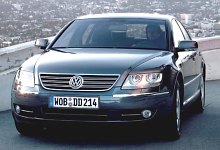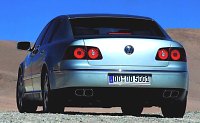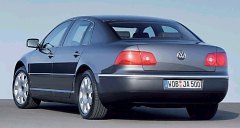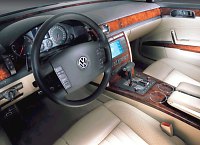|
 The
name Volkswagen, or People’s Car in English, represented Adolf Hilter’s
dream to offer every German family a car. But not a luxurious
limousine.
So why did Dr. Piech decide to take Volkswagen into the Mercedes
S-class
territory? unofficially speaking, this is a counter-attack to Mercedes’
downstreaming product lineup. If Mercedes can build an A-class to steal
sales from Golf, why not Volkswagen strike back right at the heartland
of Mercedes - the S-class segment? If Dr. Piech’s response seems too
emotional,
perhaps his successor, Bernd Pischetsrieder’s explanation will convince
you: until now just 1% of the Golf sold are the high-profit V6 model.
If
Volkswagen can lift its image to match other German premium brands,
they
may raise that figure to 5% or more, and that will earn them a lot of
profit.
Therefore, the mission of Phaeton is not to make a profit by itself but
to lift the image of Volkswagen. The
name Volkswagen, or People’s Car in English, represented Adolf Hilter’s
dream to offer every German family a car. But not a luxurious
limousine.
So why did Dr. Piech decide to take Volkswagen into the Mercedes
S-class
territory? unofficially speaking, this is a counter-attack to Mercedes’
downstreaming product lineup. If Mercedes can build an A-class to steal
sales from Golf, why not Volkswagen strike back right at the heartland
of Mercedes - the S-class segment? If Dr. Piech’s response seems too
emotional,
perhaps his successor, Bernd Pischetsrieder’s explanation will convince
you: until now just 1% of the Golf sold are the high-profit V6 model.
If
Volkswagen can lift its image to match other German premium brands,
they
may raise that figure to 5% or more, and that will earn them a lot of
profit.
Therefore, the mission of Phaeton is not to make a profit by itself but
to lift the image of Volkswagen.
To
many people, the step from Passat to Phaeton is too big and too risky.
However, don’t forget in 1989 there was a Japanese car maker succeeded
entering the S-class territory from the very ground floor. Moreover,
that
car maker was just known as the producer of Corolla. Comparatively,
today’s
Volkswagen is in a much stronger position - no matter image-wise or
engineering-wise
- to launch the challenge. It also has an established partner, Audi, to
share many expensive components and manufacturing tooling. Phaeton has
any right to be a worthy challenger to Mercedes S-class.
 Unquestionably,
Phaeton is a big car. Measuring just over 5 meters, its overall size
matches
a standard S-class. Its exterior design is conservative, but delivers a
solid image while having strong resemblance to Passat, especially the
front
end design and swooping roofline. Without any surprise, build quality
is
first class, with tightly fit panels, perfectly finished paint and very
narrow assembly gaps that pass Dr. Piech’s "sliding finger test". Open
and close the doors, you will feel this car is really solidly built. In
fact, with a torsional rigidity of 37,000 Nm/degree, it is the stiffest
chassis I know. Unquestionably,
Phaeton is a big car. Measuring just over 5 meters, its overall size
matches
a standard S-class. Its exterior design is conservative, but delivers a
solid image while having strong resemblance to Passat, especially the
front
end design and swooping roofline. Without any surprise, build quality
is
first class, with tightly fit panels, perfectly finished paint and very
narrow assembly gaps that pass Dr. Piech’s "sliding finger test". Open
and close the doors, you will feel this car is really solidly built. In
fact, with a torsional rigidity of 37,000 Nm/degree, it is the stiffest
chassis I know.
The
interior shows a similar story, conservatively styled but beautifully
built.
It employs the best wood, leather and plastics to shame S-class, and
assembled
with solidity and fitness that no one else in the industry can surpass.
Volkswagen is especially proud of the luxury equipment - a climate
control
which separates the cabin into 4 zones with individual adjustment and
18-way
adjustable power seats with massager incorporated. The only slight
disappointment
of the cabin is: although rear passengers have abundance of head and
legroom,
it does not feel as big as S-class, blame to the swooping roofline and
relatively short (2881mm) wheelbase.
 Unlike
Lexus, Volkswagen’s first attempt to the luxury segment provides a wide
range of choice of engines. These include a 420hp 6.0 W12, an
Audi-sourced
335hp 4.2 V8, a new 313hp / 553lbft 5.0 V10 turbo diesel, a 241hp 3.2
VR6
and at last a 2.5 V6 TDI. At launch, only the petrol W12 and VR6 are on
sale. Unlike
Lexus, Volkswagen’s first attempt to the luxury segment provides a wide
range of choice of engines. These include a 420hp 6.0 W12, an
Audi-sourced
335hp 4.2 V8, a new 313hp / 553lbft 5.0 V10 turbo diesel, a 241hp 3.2
VR6
and at last a 2.5 V6 TDI. At launch, only the petrol W12 and VR6 are on
sale.
The
flagship Phaeton shares its 6.0-litre W12 engine with Audi A8. Ditto
the
Torsen-differential 4WD system which is called 4motion by VW or Quattro
by Audi. The compact W12 is undoubtedly an engineering achievement, but
because we have already discussed it so much, we are not going to
repeat
its technical analysis in this report. The same goes for the 3.2-litre
VR6, which comes from Beetle RSi and Golf R32. What you need to know is
only that the VR6 is mounted longitudinally in the Phaeton and drives
through
the front wheels. Although 6-speed manual is available to the V6, most
customers will opt for the ZF 5-speed Tiptronic which is compulsory in
the W12.
Start
the W12 engine, it idles without being noticed. Even cruising on
motorway,
the engine noise is barely heard. Volkswagen really employs a lot of
sound-deadening
materials to insulate the whole cabin, even using double-layer windows
like the last generation Mercedes S-class. In fact, the Phaeton is not
unlike that car - it is so richly engineered that it tips the scale at
a Rolls-Royce-rivaling 2319kg, some 300 or more kilograms heavier than
the equivalent S600, 760Li and sister car A8 W12. Ridiculously, Phaeton
already employs aluminum bonnet, doors and boot lid to save weight.
Although
its steel monocoque chassis is considerably heavier than A8’s aluminum
spaceframe structure, the main reason for overweight is its
uncompromising
pursuit of quality and refinement.
 The
combination of weight and remarkable sound insulation makes the car
feel
slower than it is. Theoretically it can accelerate from rest to 60mph
in
under 6 seconds, but it never feel that fast. Volkswagen also claims it
can touch 178mph if electronic limiter is disabled (you can really do
that
in dealers), but that is pointless for a luxurious car so calm. The
point
is, Phaeton is not very involving to drive, thus any more performance
won’t
add any more fun. Being a luxurious car, it works out perfectly,
providing
ride quality that nearly isolate the occupants from the road. Like
Mercedes
and BMW, it employs continuously variable pneumatic springing in all 4
corners, plus Skyhook (by Mannesman-Sachs) adaptive damping. The air
suspensions
lower ride height at high speed to improve stability, it also adjusts
stiffness
according to road conditions, speed and driving style. It works
especially
well at comfort mode, providing magic carpet level of comfort, but less
satisfying in sport mode on rougher surfaces, where ride quality could
be harsh and suspension noise is pronounced. The
combination of weight and remarkable sound insulation makes the car
feel
slower than it is. Theoretically it can accelerate from rest to 60mph
in
under 6 seconds, but it never feel that fast. Volkswagen also claims it
can touch 178mph if electronic limiter is disabled (you can really do
that
in dealers), but that is pointless for a luxurious car so calm. The
point
is, Phaeton is not very involving to drive, thus any more performance
won’t
add any more fun. Being a luxurious car, it works out perfectly,
providing
ride quality that nearly isolate the occupants from the road. Like
Mercedes
and BMW, it employs continuously variable pneumatic springing in all 4
corners, plus Skyhook (by Mannesman-Sachs) adaptive damping. The air
suspensions
lower ride height at high speed to improve stability, it also adjusts
stiffness
according to road conditions, speed and driving style. It works
especially
well at comfort mode, providing magic carpet level of comfort, but less
satisfying in sport mode on rougher surfaces, where ride quality could
be harsh and suspension noise is pronounced.
Turn
into corners, although sports mode sharpens turn-in and keeps body roll
in control, although the 50-50 split all-wheel-drive system provides
bags
of grip, although the 365mm diameter front brakes with 8-pot Brembo
calipers
reduce speed quickly, you can feel the sheer size and weight of the
car.
Compare with new A8, the setting of Phaeton’s chassis bias towards safe
understeer. That means it won’t turn into corners as eagerly as
7-series
and S-class. Its steering is also less communicative, even remote, just
in the tradition of Volkswagen. This Volkswagen is a very capable car,
but again, it fails to excite its driver.
If
you spend more time on motorway, you will probably find the Phaeton
makes
sense. The powertrain is so good, the chassis is effective, the cabin
is
so refined. Only the Mercedes-rivaling price tag makes little sense.
Yes,
no matter how open-minded AutoZine is, it is still questionable whether
a Volkswagen-brand car worth the same money as a Mercedes-Benz or BMW.
I particularly dislike the car’s lack of innovation and character, as
it
just wants to match its rivals rather than offering something
different.
In this aspect, Toyota was cleverer with Lexus. On one hand the first
LS400
broke new ground in quietness and drivetrain refinement, on the other
hand
it was priced so attractive that immediately lured buyers from Mercedes.
Phaeton
is built in Dresden plant alongside sister car new Audi A8. Although
their
chassis are different, they share many other components, such as
engines
(W12, V8, V10 TDI and 2.5 TDI), gearbox, 4-wheel-drive hardware and
suspensions.
The capacity of Dresden is just 33,000 cars a year, expect the Phaeton
will account a smaller portion of that. Volkswagen didn’t talk about
making
a profit, but as we have already said, Phaeton is born to change the
way
you see Volkswagen - from People’s Car to Rich People’s Car.
|